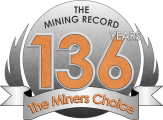RC Drill Holes Update At Toiyabe Hills Property
VANCOUVER – Westward Gold Inc. reported on two reverse-circulation (RC) drill holes (CF25-03 and CF25-04) and an update on its ongoing 2025 drilling campaign, at its Toiyabe Hills Property in Lander County, Nevada. Originally, Westward set out to test its high-priority Campfire Target Complex with approximately 5,000 metres (~16,500 feet) of RC drilling. Due to early technical and drilling successes at this framework stage, additional exploration capital was put to work to expand the program, which now includes 7,090 metres of RC drilling across eleven drill holes. Early results now include a new gold zone of 10.7m of 0.94 g Au/t, including 3.1m of 2.50 g Au/t in hole CF25-04.
The Company’s Phase 1 framework drilling program at Campfire – designed with approximately 350 to 700-metre hole spacings – was intended to characterize large-scale gold system patterns and answer key geological questions by: 1) determining the third-dimension architecture of the favourable lower-plate carbonate rocks; 2) identifying vertically-extensive Carlin-type alteration in lower-plate carbonate rocks (namely decalcification) over a large area; 3) confirming a Carlin-type gold and trace-element signature associated with the hydrothermal system; and 4) confirming the downdip expression of an igneous dike-filled fault corridor within the Campfire Anticline. To date, these key questions are being successfully answered with the Phase 1 framework drilling.
Kelly Cluer, Director, said, “As I was scrolling down the CF25-04 assay report, what really caught my attention was a 39-metre zone in the Wenban Formation containing elevated gold, arsenic, antimony and mercury, which also included 3 metres of 2+ g/t gold. This is precisely what we’ve been hoping to see at this early stage: geochemical evidence of a system that can produce both tonnage and grade, and we were rewarded in that regard in only the fourth hole back from the lab. This is a brand-new gold zone at Toiyabe Hills, essentially stumbled into with a wide-spaced drilling array. I’m more excited than ever to see what comes from the entire 2025 Campfire framework drilling campaign, and what targets will emerge as we digest all the downhole data over the winter.”
Key Drilling Highlights at the Campfire Complex: 1) The 10.7m of 0.94 g Au/t, including 3.1m of 2.50 g Au/t, in hole CF25-04 is associated with decalcified, quartz and dolomite veined silty limestone of the Wenban Formation. Arsenic, antimony and mercury – elements typically associated with Carlin-type gold systems – are elevated in this gold zone. Additionally, a 132m-thick shear zone containing strong/pervasive decalcification, quartz veining and/or selvages of silicification, discrete zones of oxidation, and elevated sooty sulfides was intersected from approximately 567m to 700m downhole. This structural zone is reminiscent of blind compressional structures that are well-documented controls for Carlin-type gold systems throughout the neighbouring Cortez District. 2) The 3.1m interval of 0.67 g Au/t in hole CF25-03 is hosted in decalcified, silicified, sooty pyrite-bearing silty limestone of the Wenban Formation. Elevated arsenic, antimony and mercury values are also characteristic of this gold zone. 3) The gold intervals in holes CF25-03 and -04 represent a new zone of gold at the Toiyabe Hills Project. 4) Nine of eleven holes have intersected favourable lower-plate carbonate rocks at direct drilling costs that are below budget at US$64 / foot. Of the ten holes collared in upper-plate rocks, eight intersected lower-plate rocks at shallower-than-anticipated depths. Vertically-extensive decalcification, an alteration type characteristic of Carlin-type gold systems, and sulfidized igneous dikes have been observed in all holes. Approximately 59% of the Phase 1 drilling metreage has been in favourable lower-plate rocks. 5) Drilling has confirmed a fully-preserved, lower-plate-hosted, Carlin-type gold system over a plan extent of approximately 1.6km by 1.0km. The hydrothermal alteration cell at Campfire remains open in all directions and at depth. 6) The framework drilling at Campfire has set Westward on a clear path to planning a 2026 Phase II drill campaign. The Company is developing solid subsurface geologic models that demonstrate lower-plate host strata is within easy reach and dipping gently to the NNE. Significant faults and mineralized dikes with known dip and within robust alteration zones can be projected into the best host rocks to target discrete structural intersections where grade is likely to increase. This is the grade hunting phase. 7) Difficult drilling conditions were encountered in drill holes CF25-01, -03, -05, -06, -09 and -09A, which resulted in either zones of no sample recovery or holes being terminated prior to fully testing the intended target.
Related Posts
TORONTO - US Copper Corp., has staked 54 new federal claims totalling 1,104 acres adjacent to…
TORONTO - Lahontan Gold Corp. has commenced drilling at its West Santa Fe project, located…
VANCOUVER - New Earth Resources Corp announced the initiation of exploration activities on its past-producing…



